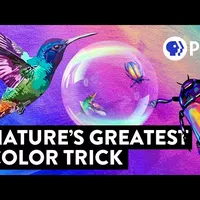How Nature Creates Colors That Aren't Really There (2)
inside of there, right?
- Yeah. - I mean,
isn't that the most amazing?
- It looks like an LED toy.
- [Jeffrey] Look at this one.
This is also an Ethiopian opal.
- [Joe] This doesn't look real.
- So you've got,
opals are made up with these little spheres of silica.
These are spheres of silica, silica and oxygen.
They're probably formed out of a silica rich solution.
These little spheres of silica are, you know,
here, you know, very tiny.
- Wow. - Point five microns
are stacked together very perfectly.
I mean, it's kinda like, you know,
we always stack oranges in a grocery store, right?
- Yeah. - They're just all
stacked together.
And so- - Wow.
- when the light hits those, they go hurrah,
and you get these great flashes
of color that we love in opals.
- They are amazingly orderly.
- Oh. - Like it looks like
somebody went in- - Nature is-
- with little tiny tweezers
and was placing these- - Well.
- one by one.
- Basically these little spaces in here,
these are about the right separation size
to cause refraction to take place.
And you get the flashes of color.
- Sure. - Well, light comes in
but what happens is light gets reflected
off of different layers. - Mhm.
- [Jeffrey] And then in some places, as the light combines,
it combines constructively and other places destructively.
- So some colors are taken out,
some are accentuated. - Some, some, that's right.
- Okay. - And as you change
the angle, that can change.
Light coming in at different angles,
different colors come off at different angles.
- As you're getting different parts of it,
you know. - [Joe] Wow.
- The orientation hits your eye.
I mean, those flashes are just unreal, aren't they?
Isn't that neat?
- That is incredible.
- Yeah.
- The ordered structures that cause iridescence
in opals are called photonic crystals,
a kind of crystal where the bending
and reflecting of light is happening
in three dimensions in a periodic or repeated pattern.
Photonic crystals are also what make these weevils
look like they were dipped in glitter.
They're like walking opals.
They are nano-sized, three-dimensional, repeating structures
in the beetle's outer shell.
Some of them are built like honeycombs
with orderly spaced pockets of air.
Others are sort of the opposite of that
with stacks of evenly spaced spheres with air in between.
And just like in an opal, light is bent,
waves combine constructively or destructively,
and different flashes of color appear.
All of these iridescent colors are the result
of physical structures that bend light,
not pigments or fluorescence
or any of the other ways that color is created in nature.
Just the strange and beautiful result
of light waves interfering with each other.
What I love most about these things,
isn't that they're beautiful.
It's that we can look at rocks and shells
and bubbles and birds and even beetles,
and despite how different they all are,
they're all tied together by this colorful bit of physics.
Kind of makes the universe feel a bit less
and a bit more mysterious.
(curious music) Stay curious.
That's right, Paul.
I think we should call ourselves The Beatles.
Oh, you made yourself,
you made it to the end screen.
Thanks.
By the way, if you haven't hit that subscribe button,
if you enjoyed this video,
now would be a great time to do that.
Hit the little bell next to it too.
You get notified as soon as we have a new video up,
and then you can watch it and like it immediately,
which helps other people find these videos
and learn cool stuff like this.
Also, wanna say a huge thank you
to everyone who supports the show on Patreon
for not only helping us amass this great beetle collection
but also for helping us make these videos.
If you'd like to join that esteemed club,
there's a link down in the description
where you can find out more,
and I will see you in the next video.
Cheerio.
And thank you to Brilliant for supporting PBS.
Brilliant is an online learning platform
for STEM with hands-on interactive lessons.
Brilliant is for curious learners
both young and old, professional and inexperienced.
Brilliant courses teach you how to think
by interactive lessons and problem-solving activities
and exercises, and they also help you solve problems
with interactive lessons in STEM.
For example, Brilliant offers a course
on scientific thinking.
Explaining the world
means thinking with scientific principles,
but usually they're cloaked
in all these technical manipulations.
Now in this course, you'll dispense with that
number crunching and math in search of something
more useful, physical insight.
There are no prerequisites for this course.
You'll explore the laws of physics
and engineering principles and learn the rules as you play.
There'll be plenty of surprises along the way,
but by the end, you'll have gained the understanding
and insight to look at the world differently.
To learn more about Brilliant,
go to brilliant.org/besmart.
Welcome to our show,
ladies and gentleman, The Beatles.
I mean, the beetles.
All right, turn that away for me.
I can't even look at myself.
(Joe laughs)

